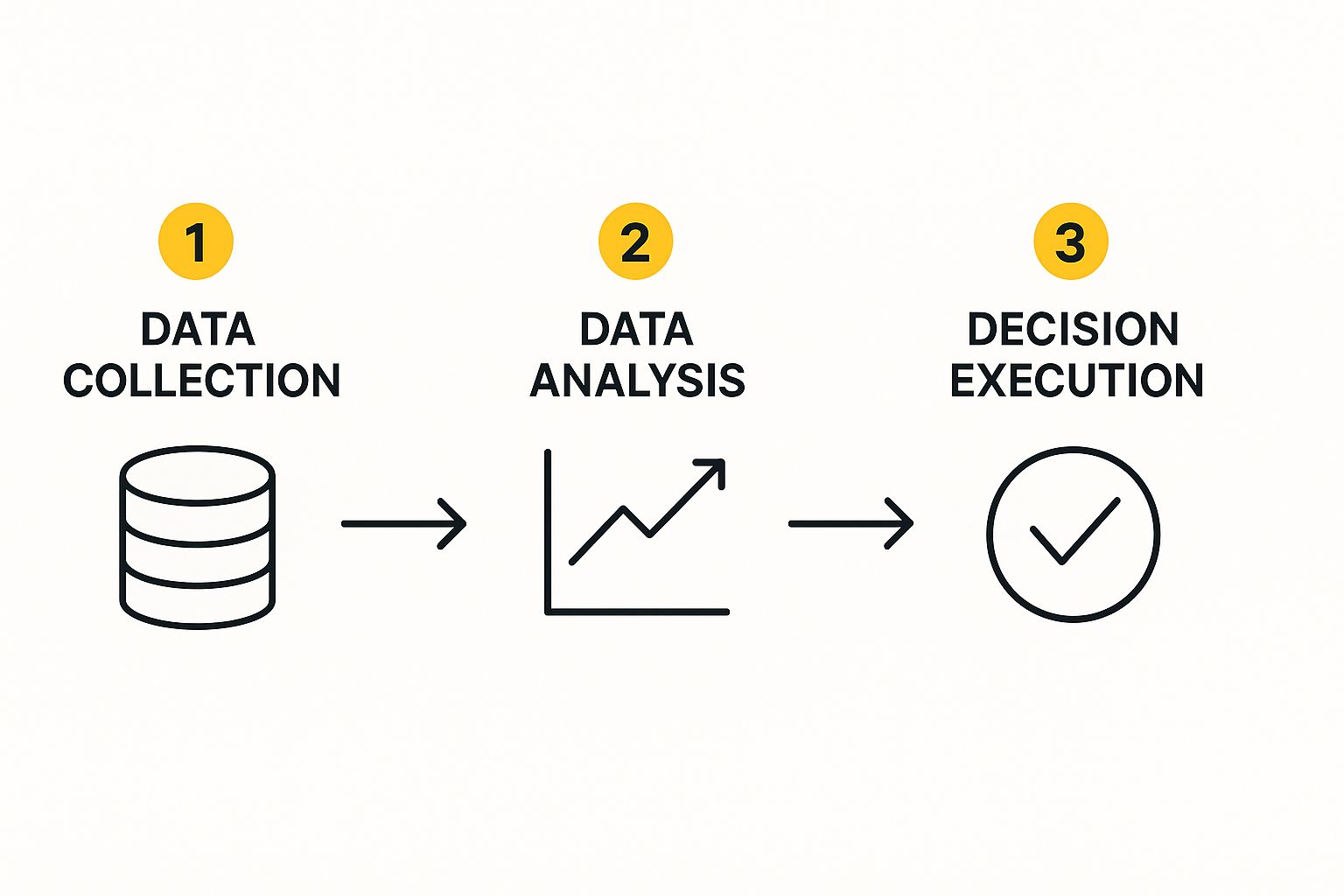In today's market, speed isn't just a nice-to-have; it’s the difference between leading the pack and getting left behind. Making decisions faster isn't about being reckless. It’s about ditching sluggish, old-school processes for agile, data-informed models that turn quick, smart choices into your most powerful weapon for growth.
Why Faster Decision Making Matters Now More Than Ever

The business world moves at an incredible pace, and teams need to respond just as quickly to shifting market demands and customer needs. Not long ago, big decisions hinged on reports that were already months old by the time they landed on someone's desk. You were either acting on stale information or just going with your gut.
Thankfully, companies are finally moving away from that broken model. Those built-in delays kill operational efficiency and bring innovation to a grinding halt. It’s a simple truth: if your team is stuck in pre-meetings for the actual decision meeting, your competitor has already shipped their next feature.
The change is about more than just speed—it’s about creating a culture where quickness and quality go hand-in-hand. Below is a look at how these two approaches stack up.
Slow vs Fast Decision Making Models
| Attribute | Traditional Model (Slow) | Agile Model (Fast) |
|---|---|---|
| Information Flow | Top-down, hierarchical, delayed | Real-time, distributed, accessible |
| Data Basis | Historical reports, often outdated | Live data, real-time feedback |
| Approval Process | Multi-layered, bureaucratic | Decentralized, team-level autonomy |
| Risk Approach | Risk-averse, avoids failure | Embraces small, fast failures |
| Innovation | Stifled by process | Encouraged and rapid |
| Team Empowerment | Low, waits for directives | High, empowered to act |
| Market Response | Reactive and lagging | Proactive and adaptive |
The contrast is stark. Moving toward an agile model isn't just an operational tweak; it's a strategic necessity for staying relevant and competitive.
From Bottlenecks to Breakthroughs
To truly thrive, you have to dismantle the structures that slow you down. The ultimate goal is an environment where teams have the real-time information and the autonomy they need to act on it decisively. This means rethinking how information travels and who gets to make the call.
The real challenge isn't just making choices faster, but creating a system where the right people have the right information at the right time. This transforms decision-making from a top-down directive into a collaborative, ground-up process.
Instead of waiting for approvals to trickle down a long chain of command, empowered teams can:
- Act on customer feedback instantly. With access to live data, they can pivot strategies on the fly and directly improve the user journey. Getting a handle on that journey is a must, and our guide on customer experience mapping can show you how.
- Innovate without asking for permission. When teams have clear goals and the data to support their ideas, they can test new concepts quickly. They learn from small failures before they ever have a chance to become big, costly ones.
- Maintain momentum. Swift decisions keep projects moving and the team’s energy high. It’s the perfect antidote to the "analysis paralysis" that plagues so many organizations and drains morale.
Laying the Groundwork for Faster Decisions
Trying to speed up decisions by simply telling people to "move faster" is a recipe for disaster. You don't get faster decisions; you get faster chaos. To truly accelerate things, you need to build a solid operational framework first—one that turns ambiguity into confident, forward motion.
It all starts with getting rid of the confusion over who actually owns a decision. Projects grind to a halt when everyone thinks they have a say, or even worse, when no one knows who’s supposed to make the final call. This is where a clear responsibility model becomes non-negotiable.
Get Clear on Roles with a DACI Framework
I've seen teams transform their decision-making speed by adopting the DACI framework. It’s a straightforward model that assigns clear roles for any key initiative, eliminating the guesswork.
Here’s how it works:
- Driver: This is the project shepherd. They’re responsible for corralling stakeholders, gathering the necessary info, and pushing the decision process forward from start to finish.
- Approver: The one person who makes the final call. They are ultimately accountable for the outcome of the decision. No committees here.
- Contributors: These are your subject matter experts. They provide essential input and recommendations, but they don't get a vote. Their voice is heard, but they don’t make the decision.
- Informed: These folks are kept in the loop on the decision's progress and final outcome. They don't need to be in the deliberation, just updated afterward.
Putting DACI in place is the fastest way to solve the "too many cooks in the kitchen" problem. It instantly clarifies who needs to be in a meeting and whose input can be gathered asynchronously, which saves an incredible amount of time.
This simple visual breaks down how a structured approach flows from data to concrete action.

As you can see, a structured approach—starting with clear data—is the bedrock for making a solid decision and executing it well.
Nurture a Culture of Safety and Urgency
Beyond just defining roles, the environment your team operates in is massive. People need to feel safe enough to pitch ideas, challenge the status quo, and even disagree with leadership without fearing backlash. This concept, psychological safety, is the foundation of any honest and effective deliberation.
When people feel safe, they’re far more likely to point out a potential risk before it blows up, saving everyone from a bad decision. A culture of safety also has a direct impact on engagement. If you want to see how your team is faring, it's worth learning about the team engagement metrics that reflect your team’s overall health.
A culture of speed and ownership isn’t built by top-down mandates. It grows from giving teams the autonomy to make choices and the safety to get some of them wrong.
Finally, you have to introduce the idea of "decision deadlines." To prevent analysis paralysis—where a decision gets debated to death—set a clear timeline. This creates a healthy sense of urgency, forcing the team to focus on what’s truly critical instead of getting lost in the weeds. It’s a simple structure that keeps the momentum going.
Using Data for Quicker and Smarter Choices

Making faster decisions doesn't mean you have to sacrifice quality. It’s actually about getting the right information in front of your team and cutting out the noise. The real key is to shift away from gut feelings and move toward evidence-based choices by embedding data into your team's daily rhythm.
This isn’t just a theoretical idea; it’s already having a massive impact. Data-driven leadership is transforming workflows, boosting both speed and accuracy. One study found that 73.5% of managers at top-performing companies rely heavily on data-driven processes. These are the organizations that consistently report faster decision cycles and, more importantly, better outcomes.
Focus on the Metrics That Matter
The first step is to avoid drowning your team in a sea of irrelevant numbers. Not all data is created equal, and bombarding people with every metric you can find is a surefire way to slow things down. Instead, for any decision you face, you need to laser-focus on the handful of Key Performance Indicators (KPIs) that actually move the needle.
Think about a marketing team trying to decide whether to pump more money into a social media campaign. They don't need to know about server uptime or the latest HR stats. What they really need to see are a few critical numbers:
- Cost Per Acquisition (CPA): How much are we paying for each new customer from this campaign?
- Click-Through Rate (CTR): Are people even paying attention to the ads?
- Conversion Rate: Of those who click, how many are actually signing up or buying?
By zeroing in on these specific KPIs, the team can have a focused, productive conversation and land on a smart decision quickly. All the noise gets filtered out, leaving only the signal.
Create Simple, Accessible Dashboards
Once you know which metrics to track, you have to make them dead simple to access. Nobody wants to dig through complicated spreadsheets or dense reports—those are barriers to faster decision making. The answer is to build simple, visual dashboards that tell a story at a glance.
The goal of a dashboard isn't to show everything; it's to tell a clear story. If someone can't understand the key takeaway in 30 seconds, the dashboard has failed.
These dashboards should become the go-to spot for your team’s most important data. Tools like Google Data Studio, Tableau, or even the built-in analytics in platforms like Jira can centralize this information, clearly showing trends and progress toward goals. This accessibility empowers every single team member—not just managers—to see the impact of their work and contribute to discussions with real confidence.
Making data easy to get to is a core principle of any nimble organization. It builds a culture of ownership and transparency where everyone feels equipped to make solid choices. To go deeper on this, check out our full guide on data-informed decision making and learn how to build this capability within your own team.
Let’s be honest: when you hear “AI,” you might picture sci-fi robots making your team’s decisions. That’s not what we’re talking about here. In reality, AI is a powerful ally that helps you accelerate team analysis by doing the heavy lifting, letting your team jump from data to decision much faster.
AI-powered systems are brilliant at combing through massive amounts of information to find patterns, spot anomalies, and pull out predictive insights. It’s the kind of work that would take a human analyst weeks, if not months, to complete. This is how you can gain a serious analytical edge without needing a whole department of data scientists.
Uncovering Hidden Insights with AI
Imagine your product team is trying to figure out why user engagement suddenly dropped off a cliff. The old-school way involves slogging through thousands of feedback comments, support tickets, and usage logs. It’s not just tedious; it’s a process where crucial details can easily be missed.
This is where an AI tool changes the game. It can chew through all that unstructured data in minutes, performing sentiment analysis on customer feedback to highlight the most common frustrations. It can even pinpoint specific user behaviors that led to the drop and tell you which customer segments were hit the hardest.
AI acts like a magnifying glass, instantly highlighting the critical pieces of information buried deep in your data. It doesn't replace human judgment; it supercharges it by presenting the most relevant facts.
This kind of analytical horsepower turns messy, complex problems into clear, actionable insights. Suddenly, your team's conversations shift from guessing what the problem is to debating the best solution based on solid evidence. For bigger picture thinking, tools like an AI business plan generator can be a massive help in gathering information and zeroing in on these key insights from the start.
From Reactive to Predictive
The most advanced AI doesn’t just tell you what happened; it helps you predict what’s likely to happen next. This is a complete game-changer, moving your team from a reactive stance to a proactive one.
Think about what this means in practice:
- Forecasting Market Shifts: AI models can analyze market data, social media chatter, and economic signals to predict shifts in consumer demand, giving you a head start on the competition.
- Optimizing Resource Allocation: By analyzing past project data, AI can predict potential bottlenecks or budget overruns before they happen, giving project managers the foresight to adjust resources effectively.
- Anticipating Customer Churn: AI can identify the subtle behaviors of customers who are at risk of leaving, allowing your team to step in with targeted retention campaigns.
This predictive power is quickly becoming a non-negotiable for competitive businesses. In fact, by 2025, AI-powered data analytics is expected to be a mainstream standard, fundamentally changing how industries turn data into actionable intelligence. This widespread adoption allows companies to automate complex analyses, reduce human bias, and forecast outcomes with much greater precision. If you want to dive deeper into this shift, you can find detailed findings on how AI will revolutionize decision-making on DataHubAnalytics.com.
By embracing these increasingly accessible AI tools, you’re not just helping your team keep up—you’re equipping them to pull ahead.
Adopting Tools for Asynchronous Collaboration

Let's be honest: endless meetings and sprawling email chains are the mortal enemies of faster decision making. They absolutely demolish deep work, lock information away in silos, and bring progress to a grinding halt. The best way I've found to fight back is to embrace asynchronous collaboration tools. It’s all about shifting the team’s center of gravity from time-sucking live meetings to focused, written communication.
This isn’t about getting rid of meetings altogether. Far from it. It's about making the meetings you do have actually count. The idea is to swap out all those routine status updates for structured, written check-ins. Everyone stays in the loop, but nobody’s calendar gets hijacked in the process. This frees up that precious face-to-face time for the gnarly, complex problems that genuinely need a live brainstorm.
Structuring Decisions Asynchronously
The real magic of going async happens when you start structuring your entire decision-making process this way. Instead of conversations just evaporating into thin air the second a Zoom call ends, every discussion is captured in a dedicated tool. This creates a crystal-clear, permanent record of the whole thought process, from the initial idea to the final call.
Imagine a product team needs to decide on a new feature. In an async world, it looks something like this:
- The Context: The project lead kicks things off by outlining the problem we're solving, the customer need, and the ultimate goal.
- The Options: Team members then jump in to propose different solutions, backing them up with pros, cons, and any relevant data.
- The Discussion: This is where the collaboration heats up. Colleagues ask clarifying questions and offer feedback directly on each proposal.
- The Choice: Finally, the designated decision-maker makes the call, explaining their reasoning based on the documented discussion.
What you're left with is an invaluable artifact. A new hire can join the project months later and instantly get up to speed on not just what was decided, but why. It builds an incredible culture of transparency and makes accountability a given. This documented history is also a lifesaver for any kind of review or audit, saving you from digging through stale emails and scattered meeting notes.
Here’s a glimpse of what a well-organized async decision hub can look like, serving as the single source of truth for the team.

You can see how an app like NASA helps organize meeting agendas and discussion points ahead of time, making sure every session is locked-in and productive. By preparing topics in advance, teams can spend their time together actually solving problems, not just playing catch-up.
Making the Workflow Seamless
Making this model work takes more than just buying a new tool subscription; it demands a real cultural shift. Your team has to commit to writing things down and, crucially, trust the process. This change is a game-changer for distributed teams scattered across time zones, as it lets everyone contribute thoughtfully on their own schedule.
The greatest benefit of asynchronous work isn't just speed; it's the quality of thought that comes from giving people the time and space to formulate their ideas without the pressure of an immediate response.
To make this transition feel natural, you need to establish some clear ground rules. Define what a reasonable response time looks like and show everyone how to structure their updates for maximum clarity. For teams already living in platforms like Jira, weaving this workflow into your day-to-day becomes much simpler. In fact, as your team grows, you can even look into concepts like automated user management in Jira to keep access and permissions tidy.
Ultimately, a structured async approach gets rid of all those "pre-meetings for the decision meetings" that plague so many organizations, freeing your team to move forward with purpose.
Common Questions About Faster Decision Making
Even with the best tools and frameworks in place, shifting to a more agile process can bring up some totally valid concerns. It's smart to tackle these questions head-on.Even with the best tools and frameworks in place, shifting to a more agile process can bring up some totally valid concerns. It's smart to tackle these questions head-on. This way, everyone feels aligned and confident in the new approach to making faster decisions.
Let's dive into some of the most common uncertainties I hear from teams.
How Can We Ensure Quality Is Not Sacrificed For Speed?
This is always the first, and most critical, question. The answer is simpler than you might think: the goal is efficiency, not recklessness. Real speed comes from clarity and focus, not from cutting corners.
You protect quality by grounding every single choice in evidence. This is where data-driven frameworks become your best friend, making sure decisions are based on objective reality instead of just gut feelings. It’s also vital to get crystal clear on the scope of a decision. Small, reversible choices? Make them quickly. But those big, high-impact, "one-way door" decisions will naturally need more deliberation and rigor.
Finally, you need to build robust feedback loops into your process.
A core principle of agile decision-making is the ability to iterate. You make a choice, act on it, see what happens, and then adjust on the fly. This ensures that even if an initial decision isn't perfect, you can correct it quickly without derailing progress.
What Is The Best Way To Handle Team Disagreements?
Let's be clear: disagreements aren't just healthy; they're essential for avoiding the trap of groupthink. The trick is to manage them constructively so they lead to better outcomes, not frustrating deadlocks.
Start by establishing a clear decision-making framework, like DACI. When everyone on the team knows who the ultimate decider is, you avoid those endless stalemates. This doesn't mean silencing dissent—quite the opposite. It provides a clear path forward once all viewpoints have been heard.
From there, you need to cultivate a "disagree and commit" culture. Team members should feel completely empowered to voice opposing opinions during the deliberation phase. But once a decision is made, everyone has to rally behind its execution. This simple rule, made famous by companies like Amazon, prevents lingering resentment and ensures the team moves as one. To make this even smoother, it's a great practice to document these discussions and outcomes, which you can learn more about in our guide to effective meeting notes and action items.
How Do We Get Leadership Buy-In To Change Our Process?
Getting your leadership on board isn't about theoretical arguments; it requires a compelling business case. You need to frame your proposal as a direct solution to a tangible problem they care about.
First, pinpoint a specific pain point that slow decision-making is causing. Maybe it's a missed market opportunity, a delayed product launch, or even low team morale from bureaucratic hurdles. Presenting a clear problem-solution story is always more persuasive.
Next, propose a pilot project. Pick a small, motivated team to test the new framework on a limited scale. You'll want to define clear success metrics for this pilot, like:
- Reducing decision time for a specific task by 50%.
- Increasing the number of experiments shipped per quarter.
- Improving team satisfaction scores related to autonomy.
When you can walk into a meeting with concrete data from a successful pilot, it provides undeniable proof of value. The conversation shifts from a risky proposal to a proven strategy, making it much easier for leadership to support a broader rollout.
Ready to stop wasting time in unproductive meetings and start making faster, smarter decisions? See how resolution's NASA app can bring structure, clarity, and accountability to your team's workflow. Explore NASA for Jira today.
